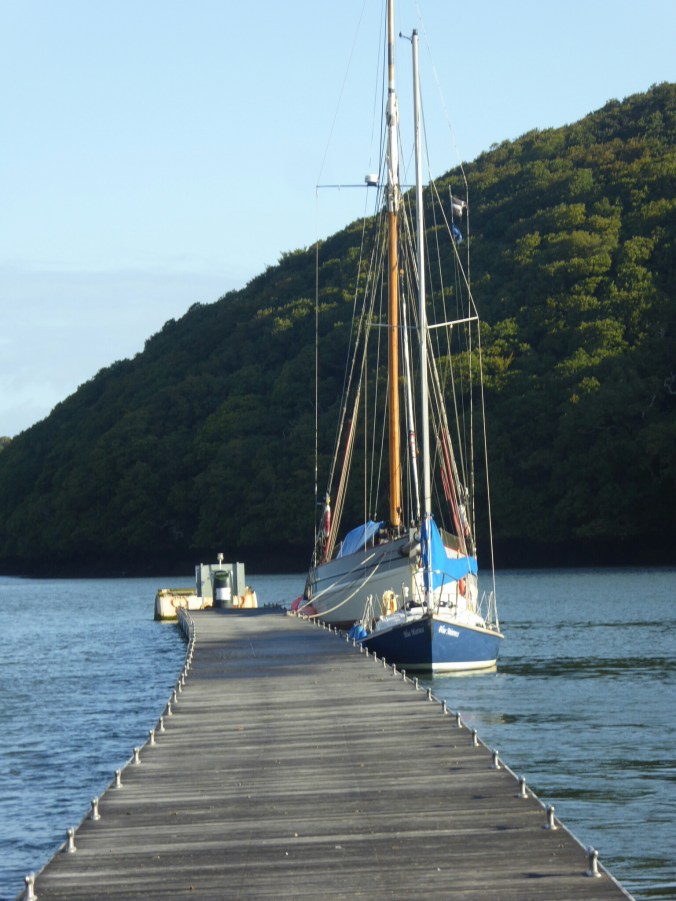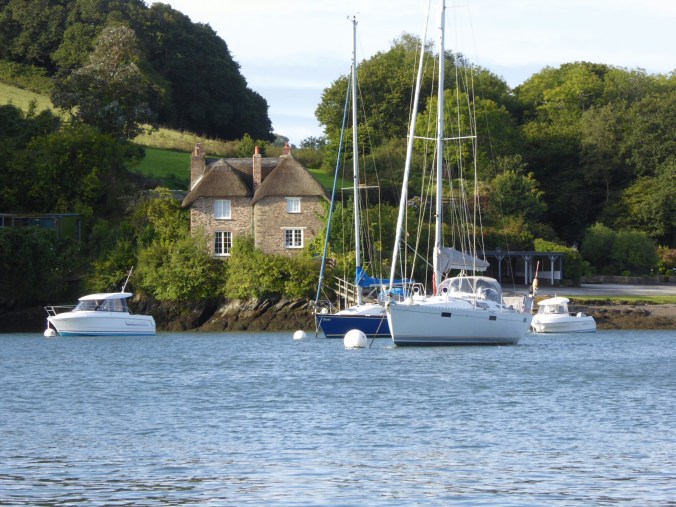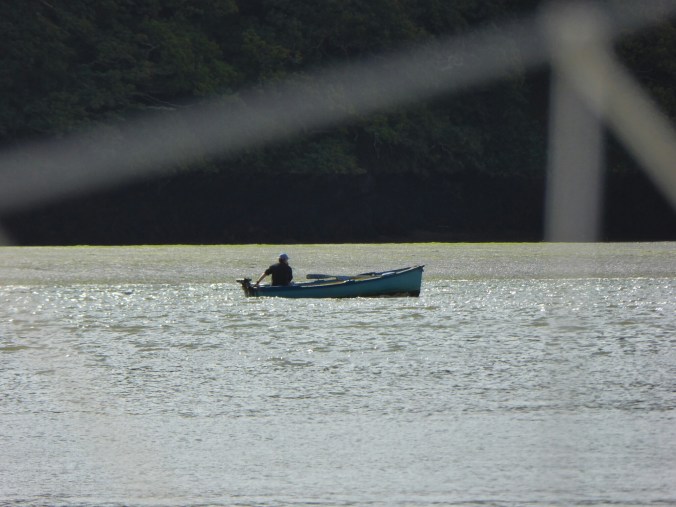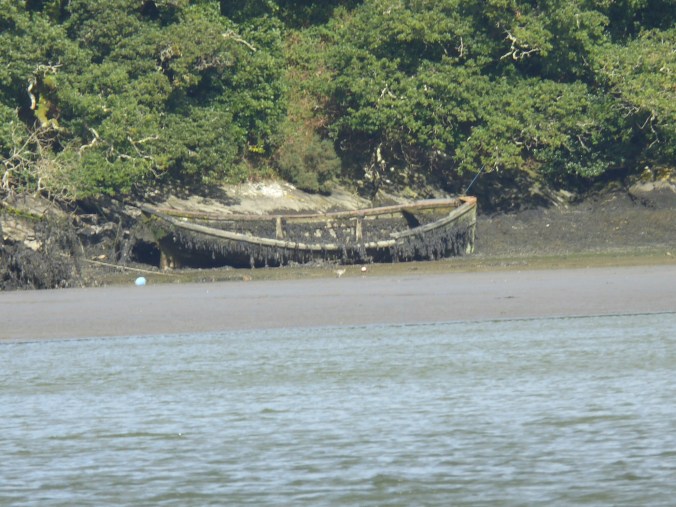5 – River Fal, ‘Old Dreadnought’
The plan was to moor for the night against one of the visitors pontoons upriver..
 The Fal Estuary and River extends from its entrance between Pendennis Point and St Anthony Head 18 km inland to Tresillian. It has a shoreline length of 127 miles and, I understand, some 4500 moorings. This pontoon is on the Truro River, just north of its junction with the Fal.
The Fal Estuary and River extends from its entrance between Pendennis Point and St Anthony Head 18 km inland to Tresillian. It has a shoreline length of 127 miles and, I understand, some 4500 moorings. This pontoon is on the Truro River, just north of its junction with the Fal.
In ‘The Survey of Cornwall’, (first published in 1602), Richard Carew wrote about this stretch of river: “Descending from Truro to the haven’s mouth by water, you are overlooked by sundry gentleman’s commodious seats . . . But amongst all, upon that side of the river, Talverne, for pleasant prospect, large scope, and other house-keeping commodities, challengeth the pre-eminence”
 My knowledge of the history of my home county is patchier than I care to admit. One of the aims of this trip is to sail into Cornwall and absorb what is around me and what comes out of it. Thus I find myself on a pontoon half a mile upriver from Smugglers Cottage, (a one-time popular tea garden and restaurant, now, sadly, closed), and Tolverne – (yes, spelt ‘Tolverne’ on the chart). The nearest ‘sundry gentleman’s commodious seat’ on the ordinance survey map is Tregothnan, home of Viscount Falmouth, whose boathouse is on the bank 100 yards away.
My knowledge of the history of my home county is patchier than I care to admit. One of the aims of this trip is to sail into Cornwall and absorb what is around me and what comes out of it. Thus I find myself on a pontoon half a mile upriver from Smugglers Cottage, (a one-time popular tea garden and restaurant, now, sadly, closed), and Tolverne – (yes, spelt ‘Tolverne’ on the chart). The nearest ‘sundry gentleman’s commodious seat’ on the ordinance survey map is Tregothnan, home of Viscount Falmouth, whose boathouse is on the bank 100 yards away.
An ancestor of Viscount Falmouth at Tregothnan was Admiral Edward Boscawen, 4th Viscount Falmouth, later 1st Earl of Falmouth. (I quote from a short history of Cornwall published for the millennium celebrations – ‘Cornwall For Ever! Kernow Bys Vyken!’). “(He was) . . . known affectionately as ‘Wry-necked Dick’ as a result of a nasty wound received in a naval battle. Another nickname was ‘Old Dreadnought’, taken from the name of one of his ships, a reflection of his fearless exploits such as the capture of the famous French ship Temeraire off Lagos in 1759. When it was rumoured that Boscawen had fallen out with the government of the day, one of his supporters wrote, ‘No! That cannot, shall not be; it would put the very ocean in a storm and the large continent of Cornwall into a rebellion’. Cornishmen relished their independence – (they still do), and if rebellion was indicated, well . . . A verse of Robert Stephens Hawker’s poem referring to the imprisonment of Bishop Trelawny in the Tower of London in 1688, and taken up as the Cornish anthem reads: ‘And have they fixed the where and when? And shall Trelawny die? Here’s twenty thousand Cornish men Will know the reason why.’  I arrived on this long pontoon around 1300 on the Friday and had a comfortable but heavy-rain-filled night. Having waited for the tide through the following morning, I left to go further upriver on the flood. The traffic on the river while I was moored was light – the pontoon was obviously a magnet for weekenders during the summer but not this weekend because of the weather. I shared it with the Bristol Channel Pilot Cutter ‘Marguerite’ – a rare privilege.
I arrived on this long pontoon around 1300 on the Friday and had a comfortable but heavy-rain-filled night. Having waited for the tide through the following morning, I left to go further upriver on the flood. The traffic on the river while I was moored was light – the pontoon was obviously a magnet for weekenders during the summer but not this weekend because of the weather. I shared it with the Bristol Channel Pilot Cutter ‘Marguerite’ – a rare privilege.  Though only there 24 hours, the rhythm of the river cast a spell. There were egrets and curlews and cormorants, the inevitable gulls, a lone seal, an inquisitive swan. The tide ebbed and flowed, uncovering and covering the mud banks.
Though only there 24 hours, the rhythm of the river cast a spell. There were egrets and curlews and cormorants, the inevitable gulls, a lone seal, an inquisitive swan. The tide ebbed and flowed, uncovering and covering the mud banks.  Downstream was the Dona Amelia – (yours for €23 million). Talking to the helpful harbour patrol, we decided that if we removed the superstructure and placed three tall masts in her we could transform this vessel. I did take some photographs. I hope they adequately reflect the time spent there.
Downstream was the Dona Amelia – (yours for €23 million). Talking to the helpful harbour patrol, we decided that if we removed the superstructure and placed three tall masts in her we could transform this vessel. I did take some photographs. I hope they adequately reflect the time spent there.
(Images by Bill Whateley)











Hi Bill
I sold my Folksong to a Portuguese guy when i left Portugal a couple of years ago and have shut myself off from boats for a bit living in Singapore.
Thinking about them once more it is nice to read your posts.
Cheers
Guy